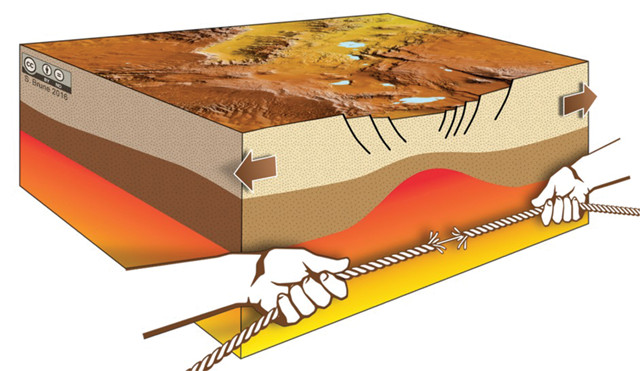
by Lucas Joel Tuesday, November 15, 2016

Like a rope tearing apart strand by strand, rifting perpetually weakens the lithosphere until it "snaps" and plate motions accelerate. Credit: S. Brune, 2016, CC BY-ND.
When continents rift, they often do so slowly at first, but then they can suddenly speed up. Why they suddenly go faster instead of rifting at a steady pace has long eluded explanation. But in a new study, researchers suggest that the lithosphere perpetually thins as it rifts, and that after passing a threshold, it snaps like a rope under too much tension, causing plate motions to accelerate.
The new work explains why the structural geology of passive margins can look different closer to continents than farther out beneath the ocean, says Jolante Van Wijk, a geophysicist at the New Mexico Institute of Mining and Technology who was not involved in the new Nature study. “There’s a zone that’s deformed, and there’s a change in the structure and the deformation patterns of the margin,” she says.
Known rift-driving forces like mantle convection, wherein hot churning mantle material helps drag continents apart, cannot explain why this zone exists, says Sascha Brune, a geophysicist at the GFZ German Research Center for Geosciences and lead author of the study. This means some other driving force must be at play to explain why continents lurch apart, creating zones of deformation in the process.
To unearth the cause, Brune and his co-authors built a database of known rifting events worldwide that included information on rift velocity as well as rift orientation — the direction at which the rift propagates with respect to the continents around it. Numerical modeling of the rifts revealed that continents can separate at rates of less than about 5 millimeters per year for tens of millions of years. But then, over the course of about 2 million to 10 million years, as the lithosphere thins, plates can accelerate to speeds of roughly 20 millimeters per year, which was the case with rifting in the central North Atlantic about 190 million years ago. “It’s original,” Van Wijk says. “It’s a very simple idea, and it explains some unexplained features really well.”
The team analyzed several ancient rifting events, finding that lithospheric thinning can help describe why each previously unexplained event happened. But even though lithospheric thinning may be the main force behind the plates’ acceleration, other factors like rift obliquity still play a role, Brune says. It takes much more force to rift continents apart at perpendicular angles.
One example is the rift that helped form the Gulf of California, which, “when it was still rifting slowly, rifted more orthogonally, so it rifted perpendicular to the trend of the Gulf,” he says. Then, about 12 million years ago, “when rifting became more oblique, it accelerated. Oblique rifting is easier to perform than orthogonal rifting, and it makes it easier to pull faster.” The same is true of other ancient rifting events, like the separation of Australia from Antarctica about 100 million years ago, he says: “It accelerated when rifting became oblique.”
Still, while rift obliquity can contribute to plate acceleration, “the most important force is lithospheric thinning,” Brune says.
As for whether or not plate accelerations as a result of thinning happen each time rifting occurs, Van Wijk says, “absolutely … you would see it everywhere a continent has broken up.” One reason, Brune says, is that plate acceleration appears to be independent of rock type; whether thinning happens in a “weak [quartz-rich] rock or a strong [olivine-rich] rock … doesn’t matter … all of them will rupture rather abruptly.” For this reason, the finding “has implications for almost all rifted margins we have on Earth,” he adds.
Still, there is more work to be done, Van Wijk notes, as other forces like volcanism are not so well understood. “I think magmatism and volcanism can also weaken the lithosphere dramatically,” she says. “So, that could be an effect to look at in the future.”
© 2008-2021. All rights reserved. Any copying, redistribution or retransmission of any of the contents of this service without the expressed written permission of the American Geosciences Institute is expressly prohibited. Click here for all copyright requests.